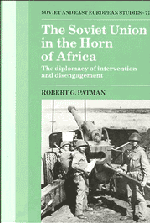Book contents
- Frontmatter
- Contents
- List of maps
- List of tables
- Preface
- List of abbreviations
- Note on transliteration of Russian words
- INTRODUCTION
- PART I MOTIVATIONAL ASPECTS
- 2 The evolution of a Soviet interest
- 3 Entering the 1970s: The Soviet disposition
- PART II THE HORN OF OPPORTUNITY
- CONCLUSION
- Appendix A Soviet–Somali treaty of 11 July 1974
- Appendix B Soviet–Ethiopian treaty of 20 November 1978
- Notes
- Bibliography
- Index
- Soviet and East European Studies
3 - Entering the 1970s: The Soviet disposition
Published online by Cambridge University Press: 29 January 2010
- Frontmatter
- Contents
- List of maps
- List of tables
- Preface
- List of abbreviations
- Note on transliteration of Russian words
- INTRODUCTION
- PART I MOTIVATIONAL ASPECTS
- 2 The evolution of a Soviet interest
- 3 Entering the 1970s: The Soviet disposition
- PART II THE HORN OF OPPORTUNITY
- CONCLUSION
- Appendix A Soviet–Somali treaty of 11 July 1974
- Appendix B Soviet–Ethiopian treaty of 20 November 1978
- Notes
- Bibliography
- Index
- Soviet and East European Studies
Summary
Having evaluated the overall balance of forces in the world, we arrived at the conclusion a few years ago that there was a real possibility for bringing about a fundamental change in the international situation.
(Leonid I. Brezhnev, General Secretary of the CPSU, in Pravda, 15 June 1974)The signing of the Nuclear Non-Proliferation Treaty in 1968 and the initiation of the Strategic Arms Limitation Talks (SALT) heralded the beginning of détente (razryadka). For Soviet commentators, the ending of the cold war marked a new stage in the global struggle between the opposed social systems of capitalism and socialism, the linchpin of which was the relationship between the USA and USSR. Washington, it was argued, was forced to accept a political dialogue principally because its previous policy, the threat of military ‘diktat’, was no longer feasible. The years 1969–70 were identified as ones in which there had been a major shift in the ‘correlation of forces’ (sootnoshenie sil) in favour of socialism. The implication of this analysis was clear. The general direction of Soviet foreign policy remained unaltered. But its potentialities for realising long-standing objectives had enormously increased. Washington, therefore, had simply been compelled to recognise these new realities, and make a retreat of historic pro-portions.
The Soviet explanation for détente is important not necessarily for the realities it unveiled but for the attitudes and perceptions it suggested. Had Soviet policy entered a new phase? How was the situation ‘qualitatively new’? Did the USSR genuinely feel the US was undergoing a steady decline of power?
- Type
- Chapter
- Information
- The Soviet Union in the Horn of AfricaThe Diplomacy of Intervention and Disengagement, pp. 58 - 110Publisher: Cambridge University PressPrint publication year: 1990



